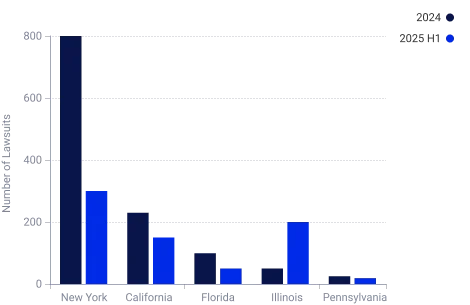ADA Website Lawsuits in 2025: What Businesses Must Know About Legal Risks and Trends
Introduction: why ADA lawsuits are rising in the USA
Over the last decade, ADA website lawsuits have become a growing concern for businesses of all sizes. Courts increasingly treat websites as “places of public accommodation” under Title III of the Americans with Disabilities Act (ADA), which prohibits discrimination in access to goods and services. The U.S. Department of Justice (DOJ) has confirmed in guidance that websites and mobile apps fall under ADA obligations, even though the statute itself does not contain technical web standards.
As a result, thousands of lawsuits are filed each year, targeting companies that fail to provide websites that people with disabilities can use.
Want to see how your website measures up? Run a free accessibility scan with Clym’s compliance scanner to identify potential issues before they become legal risks for your business.
Key statistics and lawsuit trends
ADA website lawsuits have been steadily increasing:
- In 2024, more than 4,000 lawsuits were filed in U.S. courts claiming barriers to website or mobile accessibility (Saul Ewing LLP).
- Around 40% of lawsuits were filed in New York and California (Accessibility.Works).
- Settlements often range from $5,000 to $75,000 depending on the case (Accessibility-Test.org).
Top Industries Targeted by ADA Website Lawsuits in 2024

## **2025 ADA website lawsuit trends**
The trend accelerated in 2025. According to EcomBack’s Mid-Year Report:
The trend accelerated in 2025. According to EcomBack’s Mid-Year Report:
- 2,014 lawsuits were filed in the first half of 2025, a 37% increase compared to the same period in 2024.
- Traditional hotspots like New York, California, and Florida remain high-risk, but Illinois has emerged as a new litigation center.
- Lawsuits target websites built on popular platforms such as Shopify, WordPress, Magento, and Squarespace, showing that platform choice does not shield a business from risk.
Case law shaping ADA website lawsuits
Several high-profile rulings illustrate how courts interpret ADA obligations for digital properties:
- Robles v. Domino’s Pizza (2019) – The Ninth Circuit held that Domino’s website and app must be accessible under ADA Title III, reinforcing that online services linked to physical stores fall under the ADA.
- Gil v. Winn-Dixie (2017, later appealed) – A Florida court initially found that Winn-Dixie’s website violated ADA obligations by being inaccessible to screen readers, setting one of the first major precedents.
These cases show why courts and the DOJ frequently point to WCAG standards as the practical benchmark for ADA website accessibility.
Comparison of accessibility statistics 2024 vs. 2025
Accessibility.com’s annual and monthly lawsuit reports highlight shifting litigation patterns:
Metric | 2024 (full year) | 2025 (Jan–Jun) |
|---|---|---|
Total lawsuits filed | 1,202 | 596 (Jan–Jun total from monthly recaps) |
Top targeted industries | Consumer Durables & Apparel, Food, Beverage & Tobacco, Retailing (849 cases, 71% of total) | Same three categories dominate each month, averaging 67–77% share |
Top states | New York (780 cases, 65% of total), California (236), Florida (97), Illinois (53), Pennsylvania (24) | Shifts monthly: New York (48–56% Jan–Mar), Illinois surges in Apr–May (up to 37%), California leads in June (35%) |
Most active law firms | Stein Saks, PLLC (268), Manning Law, APC (138), Gabriel A. Levy, P.C. (138), Mars Khaimov Law, PLLC (132), Pacific Trial Attorneys, APC (72) | Varies by month: Stein Saks (Feb–Mar), Equal Access Law Group (Apr–May), Manning Law (June) |
Plaintiff concentration | 62% of lawsuits filed by 5 firms | Monthly recaps show concentrated filings: e.g., Equal Access Law filed 40 in May; Manning filed 19 in June |
Repeat defendants | 48% of cases were against companies sued before | Not directly reported monthly, but trend likely continues |
Overlay tool usage | Not highlighted in 2024 report | Consistently low (<1–2%) in Jan–Jun 2025 |
Key takeaways:
- 2024 filings dropped from 2023, but 2025 is trending upward with nearly 600 lawsuits already by mid-year.
- New York’s dominance in 2024 has been partially replaced by Illinois in 2025, with California showing renewed activity by June.
- The same industries remain top targets, while lawsuits are spread across different plaintiff firms month-to-month.
- Overlay adoption remains low, suggesting these tools aren’t a factor in avoiding litigation.
Which industries are most affected
Industries most frequently targeted in ADA lawsuits include:
- E-commerce and retail – Online stores face the highest risk, given the volume of transactions and user interactions.
- Hospitality – Hotels and restaurants are often sued over booking tools or menus that don’t work with screen readers.
- Education – Schools and universities face cases involving inaccessible portals and online learning platforms.
- Healthcare – Hospitals and clinics are challenged for inaccessible patient portals and appointment booking systems.
Top Industries Targeted by ADA Website Lawsuits in 2025

The role of WCAG and ADA standards
The ADA does not define technical website requirements, but both courts and the DOJ rely on the Web Content Accessibility Guidelines (WCAG 2.1/2.2) as a standard of proof.
Examples of common WCAG issues cited in lawsuits include:
- Missing alternative text for images.
- Poor color contrast.
- Forms that cannot be completed using a keyboard.
What businesses need to do to reduce risk
Many ADA website lawsuits could be avoided if businesses took simple preventive measures. Here are some practical steps to lower the risk of ADA lawsuits:
- Conduct regular audits
Test websites against WCAG 2.1/2.2 quarterly. Use automated scans plus manual testing with assistive tech like screen readers. - Publish an accessibility statement
Outline which standards you follow, ongoing improvements, and provide a contact method for reporting issues. - Provide feedback channels
Offer a visible way for users to report accessibility barriers. Responding early often prevents escalation to lawsuits. - Adopt supportive tools
Add features that let visitors adjust text size, colors, or contrast. These tools supplement—not replace—audits. - Train staff and developers
Teach teams about ADA risks and WCAG practices. Lawsuits often cite coding errors that could have been avoided. - Monitor continuously
Accessibility isn’t one-time. Track updates to site design, plugins, and third-party tools that may introduce new barriers.
Businesses that follow these steps not only reduce litigation risk but also improve usability for all visitors.
State Comparison of ADA Website Lawsuits (2024 vs H1 2025)

How Clym supports businesses with ADA-related obligations
Clym provides tools that help businesses align with ADA Title III expectations and reduce risk exposure:
- A widget that lets visitors adjust display and report accessibility issues directly.
- Monitoring features that flag risks before they escalate.
- Templates for publishing accessibility statements.
- Integrated workflows combining accessibility, privacy, whistleblowing, and takedown features.
Want to see how your website measures up? Run a free accessibility scan with Clym’s compliance scanner to identify potential issues before they become legal risks for your business.
Penalties and enforcement
The ADA does not impose fixed fines, but lawsuits typically result in:
- Settlement costs of $5,000–$75,000.
- Attorney fees and court expenses.
- Website remediation and redesign costs.
- DOJ enforcement actions, which can include consent decrees and mandatory corrective measures.
ADA website lawsuit costs: what businesses pay
Typical costs in ADA website lawsuits can look like this:
Cost type | Estimated range |
|---|---|
Settlement amounts | $5,000 – $75,000 (case dependent) |
Attorney & court fees | $10,000 – $100,000+ |
Website remediation / redesign | $15,000 – $50,000+ (depending on complexity) |
Accessibility audits & monitoring | $5,000 – $20,000 annually |
Reputation & customer loss | Hard to quantify, but often higher than legal costs |
These figures show that settlements are only the start. The bigger cost usually comes from attorney fees, redesign work, and lost trust.
Staying ahead
The rise in ADA website lawsuits shows no sign of slowing. Businesses that implement audits, publish statements, train staff, monitor websites, and provide visitor reporting channels can significantly reduce risk while building trust.
FAQs
ADA Title III, enforced by the DOJ, treats websites and mobile apps as “public accommodations.”
Common barriers include missing image descriptions, poor color contrast, or forms that cannot be completed without a mouse.
Yes. Even single-location stores with online websites have been sued.
New York, California, and Florida consistently lead, with Illinois emerging in 2025.
More than 2,000 ADA website lawsuits were filed in the first half of 2025, a 37% increase from 2024.
Settlements typically range from $5,000 to $75,000, plus attorney fees, redesign costs, and monitoring expenses.
Courts and the DOJ frequently rely on WCAG 2.1 or 2.2 when evaluating accessibility claims.
Yes. In 2024, nearly half of cases were filed against companies that had already been sued before.
Consumer goods, food and beverage, retailing, healthcare, hospitality, and education websites are among the most frequently sued sectors.
No. Fewer than 2% of sued websites in 2025 used overlays, showing they are not a safeguard.
Begin with an accessibility audit, publish a statement, provide a feedback channel, and adopt supportive tools.
Practical measures include enabling display adjustments for visitors, training staff, continuous monitoring, and publishing transparent accessibility commitments.
Clym provides:
- A widget that lets visitors adjust display settings and report accessibility issues.
- Templates for accessibility statements and updates over time.
- A built-in feedback channel for visitors to flag problems before they escalate.
- Monitoring features that highlight risks and provide visibility into user interactions.
No. Automated tools and widgets are not substitutes for full audits. Instead, Clym facilitates ongoing efforts with reporting, customization options, and structured response workflows.